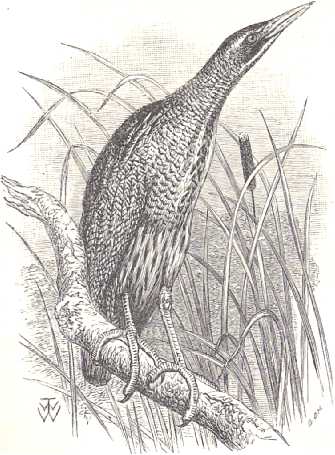|
|
|
Bitterns are part of the Ardeidae family, this
being a family which also includes herons and egrets. Within the
Ardeidae family, all members of the Botaurus and Ixobrychus genera are
called bitterns. These genera are fairly separable, to the rest of
the Ardeidae family, more perhaps on account of their partly nocturnal
habits and correspondingly-adapted coloration, than on strictly structural
grounds, though some differences of proportion are observable, bitterns
having generally shorter necks than other members of the Ardeidae family.
One particular species, The Great Bittern
is the Botaurus stellaris of ornithology, also known as the European
Bittern. It is fond of areas where reeds grow, and was formerly an abundant bird in many parts of the
UK. However since the reclamation of the bogs and fens it used to
inhabit, it has become only an irregular visitor, although each winter
it does appear in some numbers, when its unusual aspect, its large size,
and beautifully-pencilled plumage cause it to be regarded as a great attraction
for bird watchers. It particularly draws ornithologists to it in
attempts to try to spot or photograph it, as it is quite secretive bird,
preferring to stay out of sight if at all possible, therefore any sightings
or photographs are highly prized.
|

Picture of Bittern
|
Derivation and meaning of the
name Bittern
The name Bittern derives from older English "Bittour,"
"Botor," and "Buttour", cognate with the French Butor, and of is
of obscure prior origin. The word Butor seems, however, not
to be connected, as Dr. Murray thought, with the medieval Latin
Bitorius,
for
that is generally glossed Wraenna (WREN) or sometimes as "Earthlinger"
or "Yrdling." It may actually not signify a bird at all, but a Shrew-Mouse
-
Araneus, in English a "[W]ranner." Butio
seems also to be meant
by mediaeval writers in some cases, and a hopeless confusion has been established
between that word and Buteo, a Buzzard. Belon's suggestion,
made in 1555, connectd Butor with a bird described by Pliny (lib.
x. cap. xlii.), which imitates the lowing of oxen (bourn),
and hence
was called taurus in the district of Arelate (now Arles), may be
correct; for the bird is the Botaurus of some mediaeval writers,
and their name is still kept by systematists as that of the genus to which
the Bittern belongs.(According to Rolland (Faun. Pop, France, p.
376) it is known in some parts of France as Boeuf d'eau, Taureau d'etang,
and
other names of similar import). Turner, in 1544, gave as an English
synonym "Miredromble"; while "Butter-bump " (corrupted into "Botley-bump")
and perhaps other vulgar forms have reference to the booming or bellowing
sound for which this species was famous.
Habits and Sound of the Bittern
The old fable of this bird having the habit of inserting
its beak into a reed, or plunging it into the ground, and thus causing
the booming sound with which its name is associated, has long been exploded,
and in modern times very few people in Britain have ever heard its loud
(and to the ears of some, quite awful) voice, which seems to be used only
in the Spring, this being the bird's breeding season. All
the true Bitterns, so far as is known, lay eggs of a light olive-brown
colour. The incredulity as to its booming at all has in some quarters
succeeded the old belief in this as in other reputed peculiarities of the
species.
|
|
Range of the Bittern
The Bittern is found from Ireland to Japan, in India,
and throughout the whole of Africa - providing suitable localities are
available. Australia and New Zealand have a kindred species, the Australasian
Bittern, Botaurus poiciloptilus, which is said to bellow like
a bull. In North America a third species is found, the American Bittern,
Botaurus lentiginosa . Richardson, a most accurate observer,
positively asserted (Fauna Boreali: Americana,
ii. p. 374) that
its booming exactly resembles that of its European congener. The
American Bittern has several times wandered to Europe, and is distinguishable
by its smaller size and uniform greyish-brown primaries, which want the
tawny bars that characterize
the European Bittern.
|
|
|





